The history of music and song at the Middle Temple has previously been discussed in April 2018’s Archive of the Month (April 2018: Music & Song at the Middle Temple). This month we build on this and delve further into the rich history of music at the Temple by exploring the story of the choir and organ of Temple Church.
Temple Church has stood in Temple since the 12th Century when it was constructed by the Knights Templars, eventually becoming jointly owned by both Inner and Middle Temple. The Church itself has a strong connection to music and entertainment, being fitted out with an impressive organ, and is currently home to the Temple Church Choir who regularly perform there.
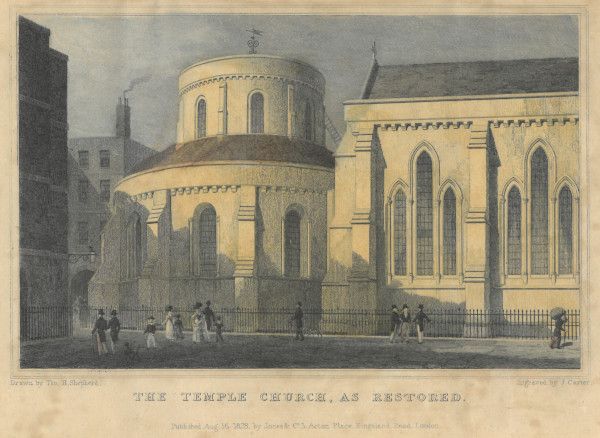
Image of Temple Church.
The Church Organ
The earliest mention of an organ in Temple Church comes from an inventory made by the Sheriffs of London in 1307 which stated that there were ‘two pairs of organs and in the quire a book for the organs and two cushions for the chanter’s chairs’ in the ‘Great Church’.
Further mention of the organ is limited until after the Great Fire of London when the Church, although undamaged, was commissioned to be refurbished by Chrisopher Wren, a renovation which involved the building of a new organ. However, as the church is the joint responsibility both Inner and Middle Temple, there was conflict between the Inns when they could not agree on which organ to install. Both Inns wanted to commission the new organ from two rival leading organ builders during that time-period, Middle preferring Bernhard Smith and Inner favouring Renatus Harris.
Here ensued a competition that became known as the ‘Battle of the Organs’, where both Inns’ chosen builder built an organ on the north and south sides of the church respectively. The competition finished in 1688 (not without rumours of the Inns sabotaging each other’s organ) and Lord Chancellor Jefferys (more famous for the Bloody Assizes of 1685) was brought in to decide the winner, eventually opting in favour of Bernhard Smith (Middle). The winning organ was installed in the summer of 1688 at the cost of £1,000. The Middle Temple Minutes of Parliament record that “The Masters of the Bench declare unanimously that the organ made by Bernard Smith for sweetness and fulness of sound, besides the extraordinary stops, quarter notes, and other rarities therein, is beyond comparison preferable to the organ made by Harris; that it is more ornamental and substantial, and both for depth of sound and strength fitter for the use of the Church.”
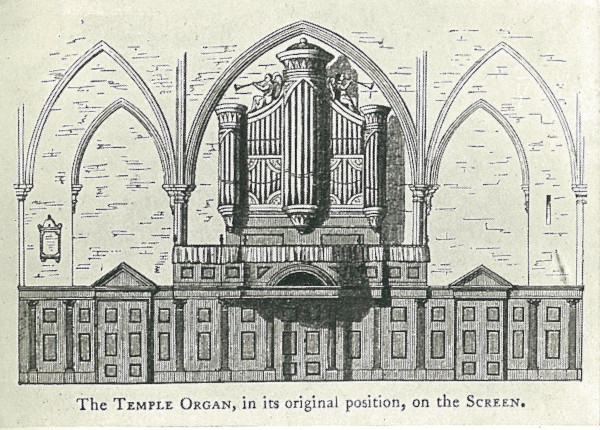
Drawing of the Temple Organ and screen.
The chosen organ was actively used by the Church, amid many repairs, for nearly three hundred years, until World War II, when it was sadly destroyed during the Blitz. In the post-war rebuilding of the church, the organ was replaced by one donated by Lord Glentannar, arriving in 1954. It was fortunate that the designs by Wren of the original organ in the 17th Century had been moved to the Bowes Museum, County Durham, in 1841, and the newly gifted organ, which remains in the church to this day, was based on these designs.
The organ, of course, requires an organist to play it. Organists were appointed by the Inns, but due to the joint ownership of Temple Church, between 1729 and 1814, both Inns appointed their own organist who played there during the services on alternate Sundays.
Middle Temple appointed Francis Piggott as their first organist in 1688, who held the role until his death in 1704, being succeeded by his son John Piggott who played until 1734. However, Francis Piggott’s tenure as organist was not without issue, as reprimanded in 1701, through an Order from Parliament for “neglecting his work and placing boys and other unskilled persons to play the organ in his place.” Piggott wasn’t the only organist to be found disregarding his duties. In 1814 the Minutes of Parliament ordered that “Miss Emily Dowding the Organist of this society be discharged for neglect of duty and that it be referred to the reconsideration of the Standing Committee what steps are necessary to be taken with respect to future appointments.”
Minutes of Parliament from 11 February 1814 ordering the removal of Emily Dowding as the Temple Church Organist.
Being the Temple Church organist brought with it a range of responsibilities such as conducting the Musical Service every Sunday morning, alongside other days when required. They were to conduct the practice of and instruct the Choir Boys and prepare the Monthly Scheme for the Music. The below image shows an advert for the appointment of an organist from February 1898.
Details regarding the appointment of Organist at Temple Church [MT/15/FIL/30].
One famous organist, appointed by Inner Temple, was the blind organist John Stanley, who played from 1734 until his death in 1786. Stanley was an excellent musician, who was also selected to be Master of the King’s Band under George III. Stanley was cause of Handel visiting Temple Church in order to see him (Stanley) perform, also teaching Handel how to conduct after he had gone blind.
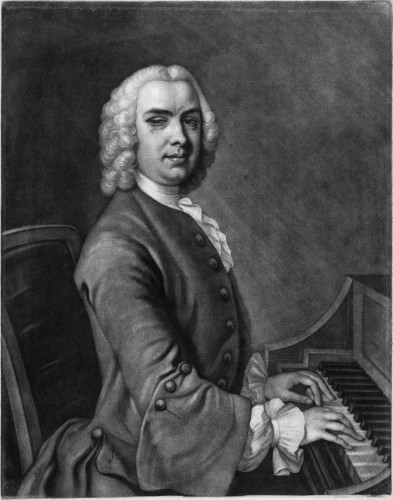
Image of Organist John Stanley.
The Temple Church organ itself was in regular use, requiring attention and repairs to ensure its upkeep. Many bills and receipts for services to the organ can be found in the Middle Temple Archive, showing expenditure such as, in 1828, 160 guineas being spent on repairs. In May 1840, J C Bishop sent the Inn an estimate for repairs and improvements needing to be completed on the organ. He referred to the need for pedal pipes to be added and regilding of the front pipes alongside the thorough cleaning of the organ for regulating its tone.
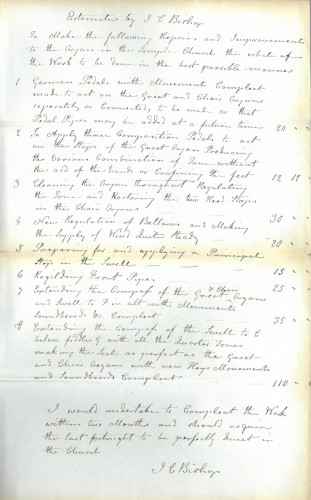
Mr Bishop's estimate for repairing the organ, May 1840 [MT/15/TAM/263].
Not everyone in Temple was a fan of the organ, and it was subject to noise complaints from members living in and around the Inn. For example, in 1954, a Mr R Travers complained of being disturbed by the “frequent and low playing of the organ in the Temple Church at most hours of the day.” However, these complaints were few and to this day the Temple Church welcomes many visitors from all over the world who come to listen to the organ being played.
The Church Choir
The organ is not the only source of music in Temple Church: a choir existed as early as the twelfth century when it was first built. Throughout the 1540s, there was reference to singing occurring at Divine services, and in 1554, the Inn recorded a request for fees from members that would be allocated to pay for singing men and to provide books for those singing in the choir, requesting “in the Middle Temple 12d from every Bencher and 4d from members of the House.”
Unfortunately, the choir slowly wound up. The rudiments of a choir were reintroduced by Organist George Warne in 1828 when two female singers, Mrs Taylor and Miss Flower were offered 14 guineas per annum to sing in Church. On 21 May 1828, it was recommended that the female singers should continue, being joined by an additional male singer.
Eventually, in the 1840s, the Inns fully revived the Church’s medieval choir of men and boys, when in 1842 the Middle Temple Bench recommended that a permanent choir be established, which has since become one of the most famous church-choirs in England. On 20 November 1842, the Church’s newly re-instated choir launched consisting of six boys, two altos, a tenor, and a bass. A Joint Choir Committee was set up to regulate and run the Temple Church Choir, which was to be directed by Edward J Hopkins, who did so for 55 years, from 1843-1898.
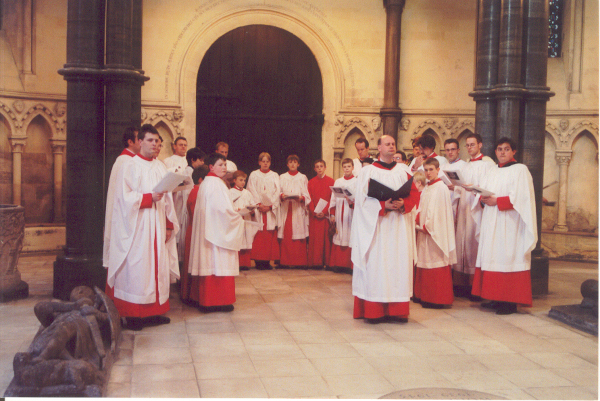
Image of the Church Choir singing in the Temple Church Round.
As musical recordings came into prominence, encouraged by previous organist Walford Davis, the Temple Church commissioned a recording of Mendelssohn’s ‘Hear My Prayer’ in 1927. To the surprise of many, the record was an instant success, bringing the choir to high acclaim, and has since never been out of catalogue. The accomplishment also led to the Temple Choir being asked to sing at the coronation of George VI and Queen Elizabeth in 1937.
The choir shot to further fame in 2003 when The Veil of the Temple, directed by Sir John Tavener received its world premiere performance at Temple Church, running for over seven hours, from night to dawn. The Veil was described in the programme by Tavener as a ‘vigil’, not quite a liturgical ceremony. Through its eight cycles, gradually rising an octave in pitch, it attempts to reveal the mystery of the death and burial of Christ through His rising.”
The choir are still present at Temple Church today, formed of eighteen boy-chorister and twelve Choirmen: now a world-famous choir who have toured around the world and produced a variety of records.
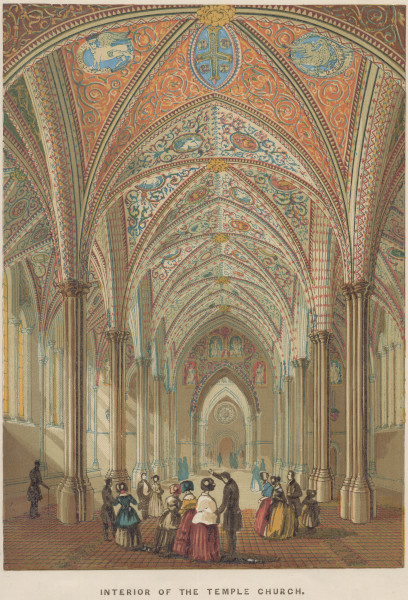
Interior view of the Temple Church.
Since Temple Church was built, it has held a dominant presence over the lands of Temple, especially with regards to music, the organ and choir having provided much entertainment for both members and visitors over the years. The church still operates with services today, and a visit is recommended to visit to see the interior of the building and experience the music created within it.